Unit 8 Detective stories单元测试卷(含答案)译林版英语九年级上册
文档属性
| 名称 | Unit 8 Detective stories单元测试卷(含答案)译林版英语九年级上册 | 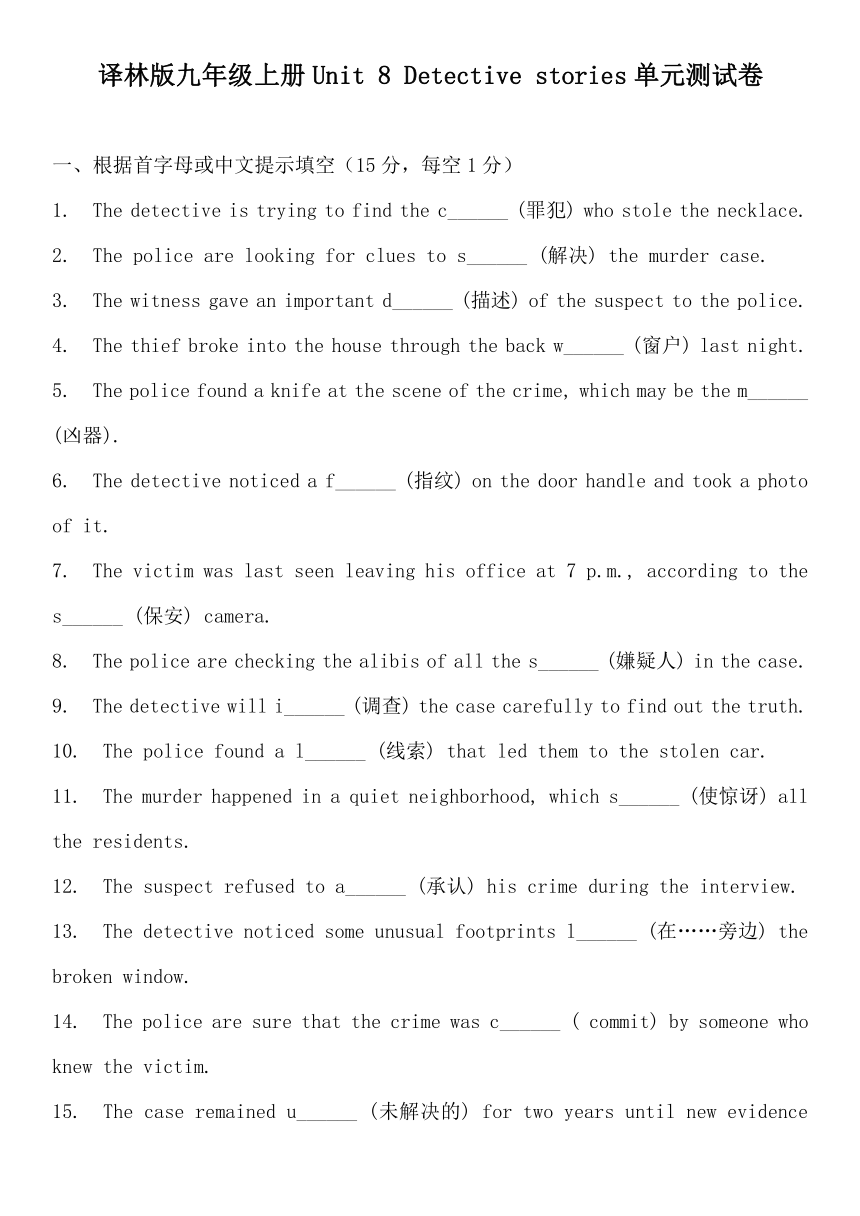 | |
| 格式 | docx | ||
| 文件大小 | 18.9KB | ||
| 资源类型 | 教案 | ||
| 版本资源 | 牛津译林版 | ||
| 科目 | 英语 | ||
| 更新时间 | 2025-07-10 21:20:37 | ||
图片预览

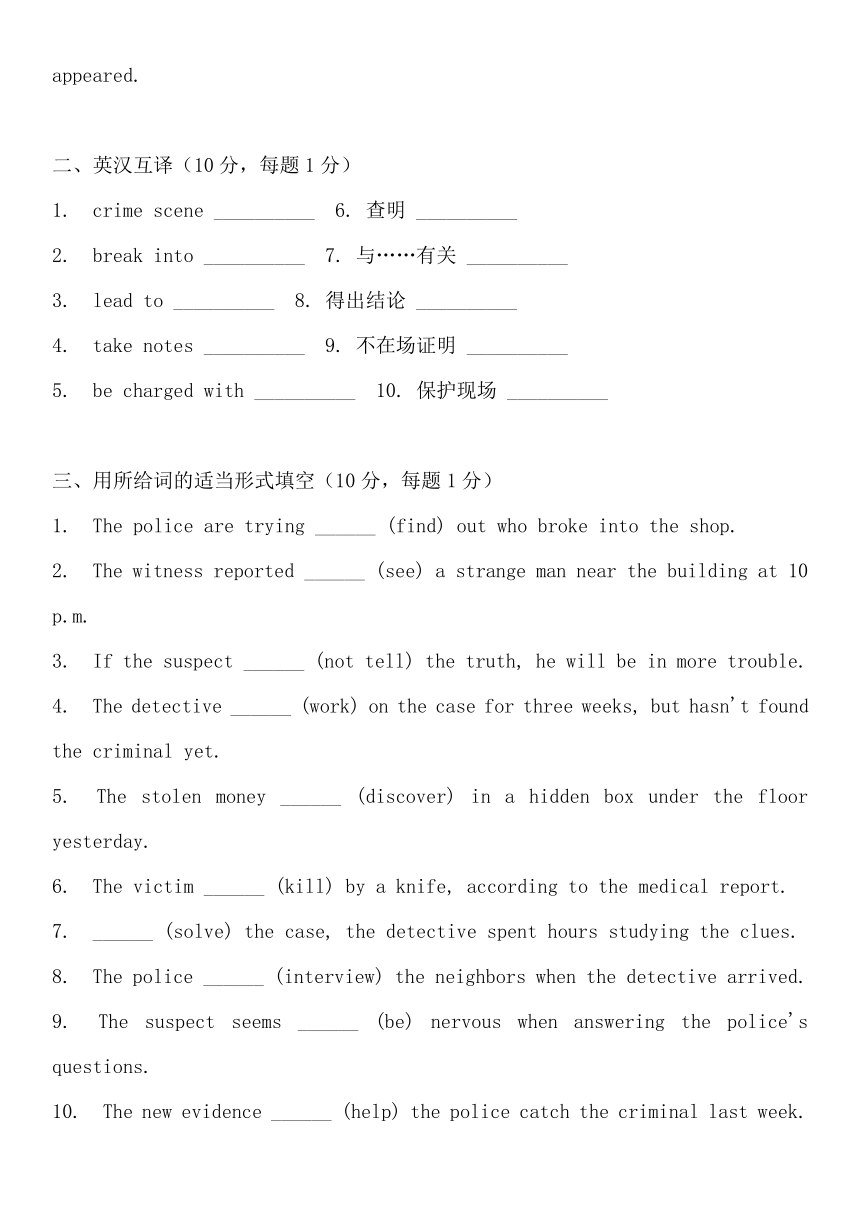
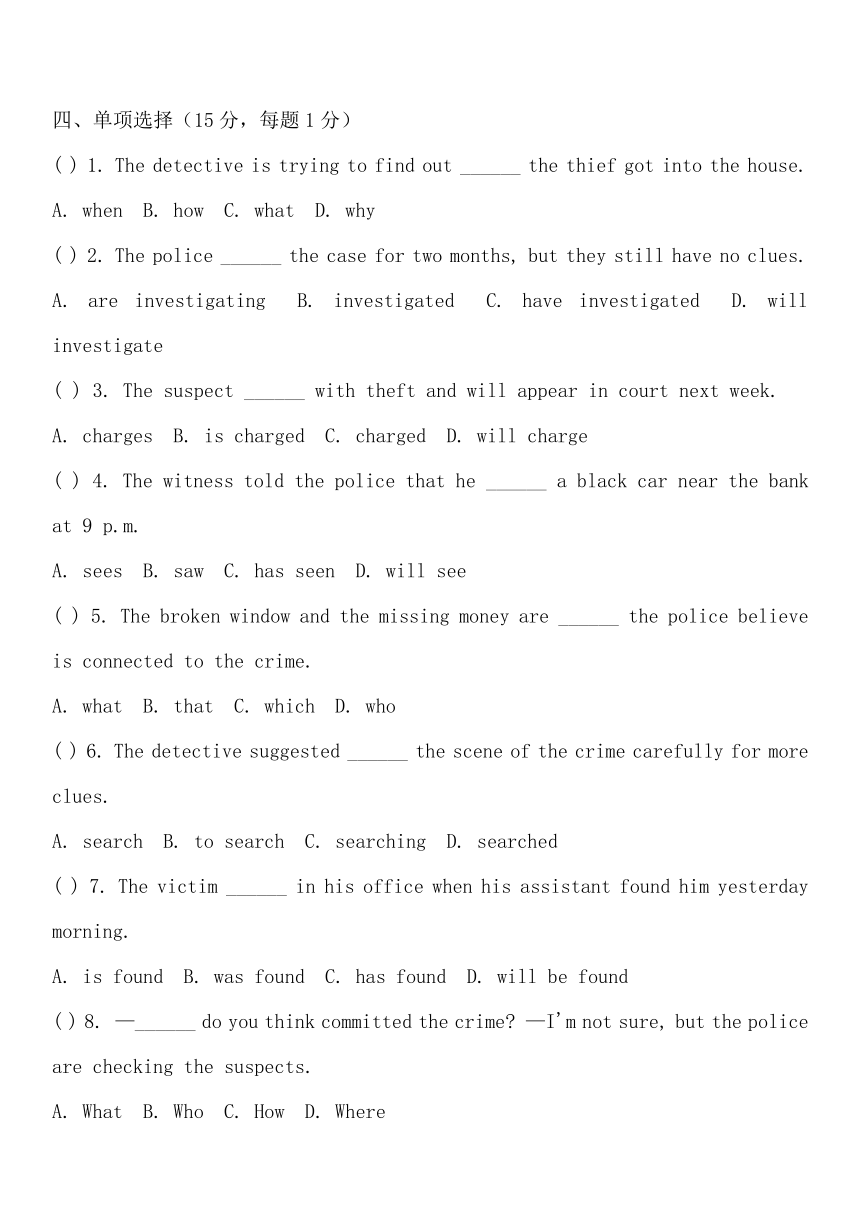
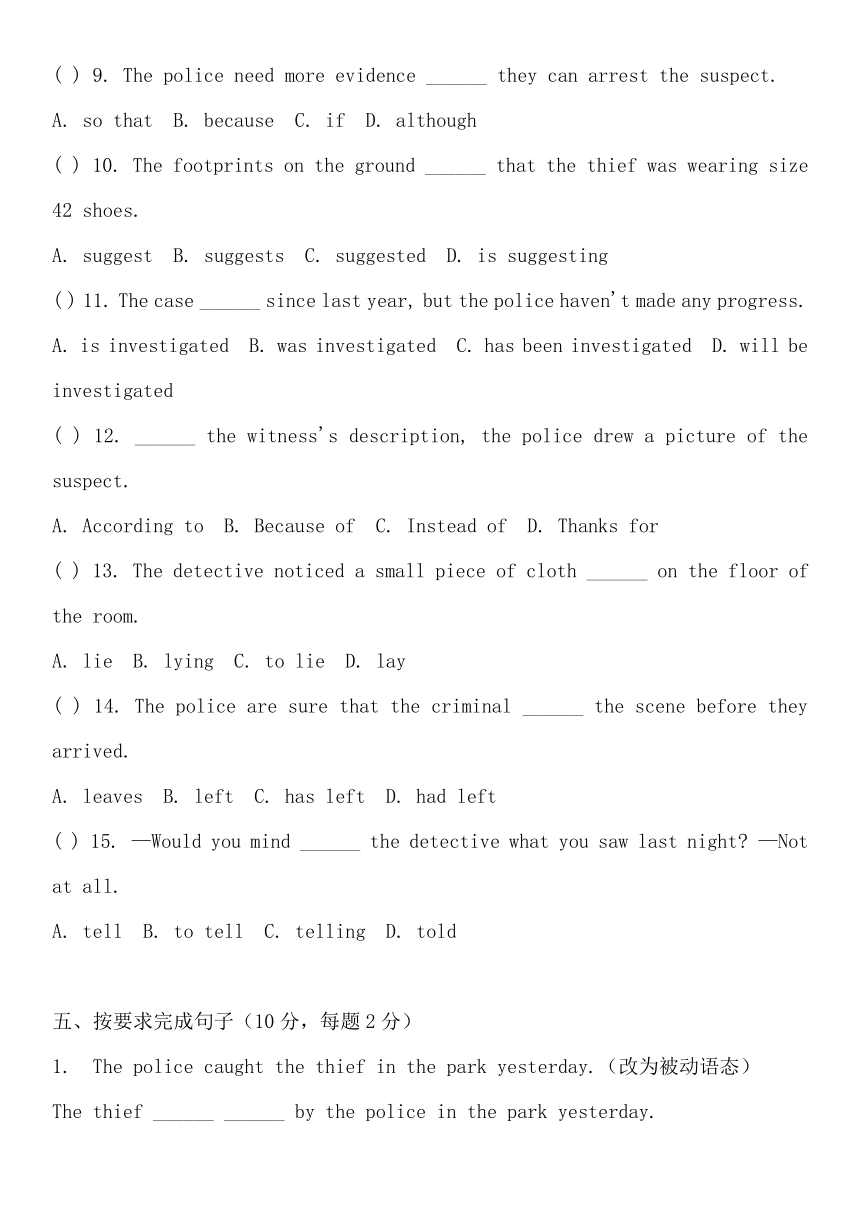
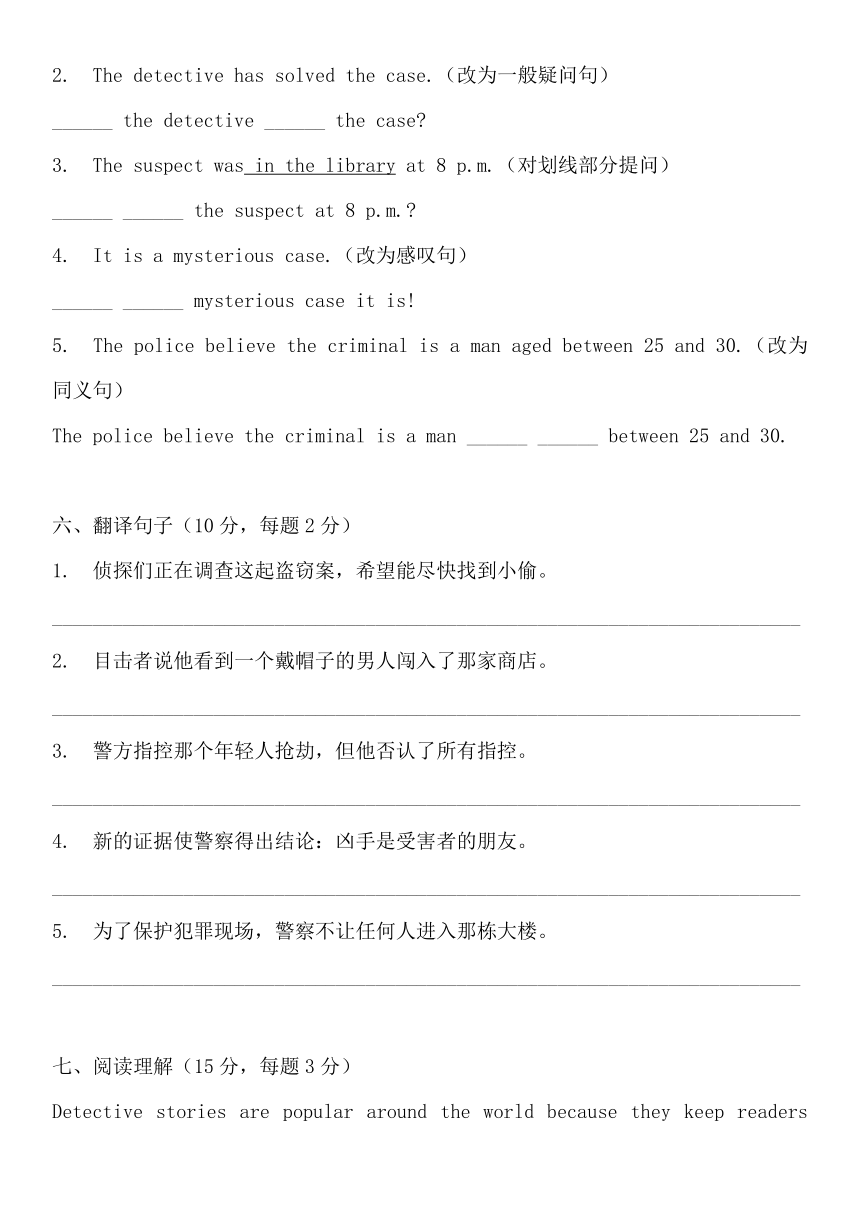
文档简介
译林版九年级上册Unit 8 Detective stories单元测试卷
一、根据首字母或中文提示填空(15分,每空1分)
1. The detective is trying to find the c______ (罪犯) who stole the necklace.
2. The police are looking for clues to s______ (解决) the murder case.
3. The witness gave an important d______ (描述) of the suspect to the police.
4. The thief broke into the house through the back w______ (窗户) last night.
5. The police found a knife at the scene of the crime, which may be the m______ (凶器).
6. The detective noticed a f______ (指纹) on the door handle and took a photo of it.
7. The victim was last seen leaving his office at 7 p.m., according to the s______ (保安) camera.
8. The police are checking the alibis of all the s______ (嫌疑人) in the case.
9. The detective will i______ (调查) the case carefully to find out the truth.
10. The police found a l______ (线索) that led them to the stolen car.
11. The murder happened in a quiet neighborhood, which s______ (使惊讶) all the residents.
12. The suspect refused to a______ (承认) his crime during the interview.
13. The detective noticed some unusual footprints l______ (在……旁边) the broken window.
14. The police are sure that the crime was c______ ( commit) by someone who knew the victim.
15. The case remained u______ (未解决的) for two years until new evidence appeared.
二、英汉互译(10分,每题1分)
1. crime scene __________ 6. 查明 __________
2. break into __________ 7. 与……有关 __________
3. lead to __________ 8. 得出结论 __________
4. take notes __________ 9. 不在场证明 __________
5. be charged with __________ 10. 保护现场 __________
三、用所给词的适当形式填空(10分,每题1分)
1. The police are trying ______ (find) out who broke into the shop.
2. The witness reported ______ (see) a strange man near the building at 10 p.m.
3. If the suspect ______ (not tell) the truth, he will be in more trouble.
4. The detective ______ (work) on the case for three weeks, but hasn't found the criminal yet.
5. The stolen money ______ (discover) in a hidden box under the floor yesterday.
6. The victim ______ (kill) by a knife, according to the medical report.
7. ______ (solve) the case, the detective spent hours studying the clues.
8. The police ______ (interview) the neighbors when the detective arrived.
9. The suspect seems ______ (be) nervous when answering the police's questions.
10. The new evidence ______ (help) the police catch the criminal last week.
四、单项选择(15分,每题1分)
( ) 1. The detective is trying to find out ______ the thief got into the house.
A. when B. how C. what D. why
( ) 2. The police ______ the case for two months, but they still have no clues.
A. are investigating B. investigated C. have investigated D. will investigate
( ) 3. The suspect ______ with theft and will appear in court next week.
A. charges B. is charged C. charged D. will charge
( ) 4. The witness told the police that he ______ a black car near the bank at 9 p.m.
A. sees B. saw C. has seen D. will see
( ) 5. The broken window and the missing money are ______ the police believe is connected to the crime.
A. what B. that C. which D. who
( ) 6. The detective suggested ______ the scene of the crime carefully for more clues.
A. search B. to search C. searching D. searched
( ) 7. The victim ______ in his office when his assistant found him yesterday morning.
A. is found B. was found C. has found D. will be found
( ) 8. —______ do you think committed the crime —I'm not sure, but the police are checking the suspects.
A. What B. Who C. How D. Where
( ) 9. The police need more evidence ______ they can arrest the suspect.
A. so that B. because C. if D. although
( ) 10. The footprints on the ground ______ that the thief was wearing size 42 shoes.
A. suggest B. suggests C. suggested D. is suggesting
( ) 11. The case ______ since last year, but the police haven't made any progress.
A. is investigated B. was investigated C. has been investigated D. will be investigated
( ) 12. ______ the witness's description, the police drew a picture of the suspect.
A. According to B. Because of C. Instead of D. Thanks for
( ) 13. The detective noticed a small piece of cloth ______ on the floor of the room.
A. lie B. lying C. to lie D. lay
( ) 14. The police are sure that the criminal ______ the scene before they arrived.
A. leaves B. left C. has left D. had left
( ) 15. —Would you mind ______ the detective what you saw last night —Not at all.
A. tell B. to tell C. telling D. told
五、按要求完成句子(10分,每题2分)
1. The police caught the thief in the park yesterday.(改为被动语态)
The thief ______ ______ by the police in the park yesterday.
2. The detective has solved the case.(改为一般疑问句)
______ the detective ______ the case
3. The suspect was in the library at 8 p.m.(对划线部分提问)
______ ______ the suspect at 8 p.m.
4. It is a mysterious case.(改为感叹句)
______ ______ mysterious case it is!
5. The police believe the criminal is a man aged between 25 and 30.(改为同义句)
The police believe the criminal is a man ______ ______ between 25 and 30.
六、翻译句子(10分,每题2分)
1. 侦探们正在调查这起盗窃案,希望能尽快找到小偷。
__________________________________________________________________________
2. 目击者说他看到一个戴帽子的男人闯入了那家商店。
__________________________________________________________________________
3. 警方指控那个年轻人抢劫,但他否认了所有指控。
__________________________________________________________________________
4. 新的证据使警察得出结论:凶手是受害者的朋友。
__________________________________________________________________________
5. 为了保护犯罪现场,警察不让任何人进入那栋大楼。
__________________________________________________________________________
七、阅读理解(15分,每题3分)
Detective stories are popular around the world because they keep readers guessing until the end. A good detective story usually has a clever detective, a puzzling crime, and many suspects with secrets.
In most detective stories, a crime happens at the beginning—maybe a theft, a robbery, or even a murder. The detective arrives to investigate. He or she looks for clues at the crime scene, like fingerprints, footprints, or broken windows. These clues can help the detective figure out what happened.
Next, the detective interviews witnesses and suspects. Witnesses may have seen something important, while suspects often have something to hide. The detective listens carefully to their stories and checks their alibis—proof that they were somewhere else when the crime happened.
As the story goes on, the detective puts the clues together. Sometimes there are red herrings—false clues that make the reader think someone is guilty, but they're not. This makes the story more exciting.
Finally, the detective solves the case. He or she explains how all the clues fit together and reveals who the criminal is. The best detective stories surprise readers with the solution, but when the detective explains it, everything makes sense.
( ) 1. What makes detective stories popular
A. They are short and easy to read. B. They keep readers guessing until the end.
C. They always have happy endings. D. They are about famous people.
( ) 2. What do detectives look for at the crime scene
A. Witnesses. B. Suspects. C. Clues. D. Alibis.
( ) 3. What is an alibi
A. A false clue. B. Proof that someone was elsewhere during the crime.
C. A witness's story. D. A broken window or footprint.
( ) 4. What are "red herrings" in a detective story
A. Clever detectives. B. True clues that lead to the criminal.
C. False clues that mislead readers. D. Witnesses who lie.
( ) 5. How does a good detective story end
A. The crime remains unsolved. B. The detective is revealed as the criminal.
C. The solution surprises readers but makes sense. D. The suspects escape.
八、书面表达(15分)
以 “A Mysterious Case I Heard” 为题,写一篇短文,内容需包含:
1. 案件的基本情况(如发生时间、地点、经过等);
2. 侦探或警方的调查过程;
3. 案件的结果及你的感受。
要求:语句通顺,不少于80词,可适当发挥。
__________________________________________________________________________
__________________________________________________________________________
__________________________________________________________________________
__________________________________________________________________________
__________________________________________________________________________
__________________________________________________________________________
__________________________________________________________________________
__________________________________________________________________________
__________________________________________________________________________
__________________________________________________________________________
答案
一、1. criminal 2. solve 3. description 4. window 5. murder weapon 6. fingerprint 7. security 8. suspects 9. investigate 10. clue 11. surprised 12. admit 13. beside mitted 15. unsolved
二、1. 犯罪现场 2. 闯入 3. 导致 4. 做笔记 5. 被指控 6. find out 7. be related to 8. draw a conclusion 9. alibi 10. protect the scene
三、1. to find 2. seeing 3. doesn't tell 4. has worked 5. was discovered 6. was killed 7. To solve 8. were interviewing 9. to be 10. helped
四、1. B 2. C 3. B 4. B 5. A 6. C 7. B 8. B 9. A 10. A 11. C 12. A 13. B 14. D 15. C
五、1. was caught 2. Has; solved 3. Where was 4. What a 5. aged
六、1. Detectives are investigating the theft case and hope to find the thief as soon as possible. 2. The witness said he saw a man with a hat break into the shop. 3. The police charged the young man with robbery, but he denied all the charges. 4. The new evidence made the police draw the conclusion that the murderer was the victim's friend. 5. To protect the crime scene, the police didn't allow anyone to enter the building.
七、1. B 2. C 3. B 4. C 5. C
书面表达范文
A Mysterious Case I Heard
Last month, a mysterious theft happened in our neighborhood. A valuable painting was stolen from Mr. Li's house while he was on vacation. The house door wasn't broken, which made the police think the thief might be someone Mr. Li knew.
The detective in charge checked the security cameras first and found a man wearing a mask entering the house at midnight. He then interviewed Mr. Li's neighbors and friends. One neighbor said she saw Mr. Li's former assistant visit the house a few days before the theft. The detective checked the assistant's alibi and found he had lied about where he was that night.
Finally, the police searched the assistant's home and found the painting hidden in his basement. He admitted he stole it because he needed money. I was surprised that someone Mr. Li trusted would do such a thing. It taught me that appearances can be deceiving, and solving a case needs careful investigation.
一、根据首字母或中文提示填空(15分,每空1分)
1. The detective is trying to find the c______ (罪犯) who stole the necklace.
2. The police are looking for clues to s______ (解决) the murder case.
3. The witness gave an important d______ (描述) of the suspect to the police.
4. The thief broke into the house through the back w______ (窗户) last night.
5. The police found a knife at the scene of the crime, which may be the m______ (凶器).
6. The detective noticed a f______ (指纹) on the door handle and took a photo of it.
7. The victim was last seen leaving his office at 7 p.m., according to the s______ (保安) camera.
8. The police are checking the alibis of all the s______ (嫌疑人) in the case.
9. The detective will i______ (调查) the case carefully to find out the truth.
10. The police found a l______ (线索) that led them to the stolen car.
11. The murder happened in a quiet neighborhood, which s______ (使惊讶) all the residents.
12. The suspect refused to a______ (承认) his crime during the interview.
13. The detective noticed some unusual footprints l______ (在……旁边) the broken window.
14. The police are sure that the crime was c______ ( commit) by someone who knew the victim.
15. The case remained u______ (未解决的) for two years until new evidence appeared.
二、英汉互译(10分,每题1分)
1. crime scene __________ 6. 查明 __________
2. break into __________ 7. 与……有关 __________
3. lead to __________ 8. 得出结论 __________
4. take notes __________ 9. 不在场证明 __________
5. be charged with __________ 10. 保护现场 __________
三、用所给词的适当形式填空(10分,每题1分)
1. The police are trying ______ (find) out who broke into the shop.
2. The witness reported ______ (see) a strange man near the building at 10 p.m.
3. If the suspect ______ (not tell) the truth, he will be in more trouble.
4. The detective ______ (work) on the case for three weeks, but hasn't found the criminal yet.
5. The stolen money ______ (discover) in a hidden box under the floor yesterday.
6. The victim ______ (kill) by a knife, according to the medical report.
7. ______ (solve) the case, the detective spent hours studying the clues.
8. The police ______ (interview) the neighbors when the detective arrived.
9. The suspect seems ______ (be) nervous when answering the police's questions.
10. The new evidence ______ (help) the police catch the criminal last week.
四、单项选择(15分,每题1分)
( ) 1. The detective is trying to find out ______ the thief got into the house.
A. when B. how C. what D. why
( ) 2. The police ______ the case for two months, but they still have no clues.
A. are investigating B. investigated C. have investigated D. will investigate
( ) 3. The suspect ______ with theft and will appear in court next week.
A. charges B. is charged C. charged D. will charge
( ) 4. The witness told the police that he ______ a black car near the bank at 9 p.m.
A. sees B. saw C. has seen D. will see
( ) 5. The broken window and the missing money are ______ the police believe is connected to the crime.
A. what B. that C. which D. who
( ) 6. The detective suggested ______ the scene of the crime carefully for more clues.
A. search B. to search C. searching D. searched
( ) 7. The victim ______ in his office when his assistant found him yesterday morning.
A. is found B. was found C. has found D. will be found
( ) 8. —______ do you think committed the crime —I'm not sure, but the police are checking the suspects.
A. What B. Who C. How D. Where
( ) 9. The police need more evidence ______ they can arrest the suspect.
A. so that B. because C. if D. although
( ) 10. The footprints on the ground ______ that the thief was wearing size 42 shoes.
A. suggest B. suggests C. suggested D. is suggesting
( ) 11. The case ______ since last year, but the police haven't made any progress.
A. is investigated B. was investigated C. has been investigated D. will be investigated
( ) 12. ______ the witness's description, the police drew a picture of the suspect.
A. According to B. Because of C. Instead of D. Thanks for
( ) 13. The detective noticed a small piece of cloth ______ on the floor of the room.
A. lie B. lying C. to lie D. lay
( ) 14. The police are sure that the criminal ______ the scene before they arrived.
A. leaves B. left C. has left D. had left
( ) 15. —Would you mind ______ the detective what you saw last night —Not at all.
A. tell B. to tell C. telling D. told
五、按要求完成句子(10分,每题2分)
1. The police caught the thief in the park yesterday.(改为被动语态)
The thief ______ ______ by the police in the park yesterday.
2. The detective has solved the case.(改为一般疑问句)
______ the detective ______ the case
3. The suspect was in the library at 8 p.m.(对划线部分提问)
______ ______ the suspect at 8 p.m.
4. It is a mysterious case.(改为感叹句)
______ ______ mysterious case it is!
5. The police believe the criminal is a man aged between 25 and 30.(改为同义句)
The police believe the criminal is a man ______ ______ between 25 and 30.
六、翻译句子(10分,每题2分)
1. 侦探们正在调查这起盗窃案,希望能尽快找到小偷。
__________________________________________________________________________
2. 目击者说他看到一个戴帽子的男人闯入了那家商店。
__________________________________________________________________________
3. 警方指控那个年轻人抢劫,但他否认了所有指控。
__________________________________________________________________________
4. 新的证据使警察得出结论:凶手是受害者的朋友。
__________________________________________________________________________
5. 为了保护犯罪现场,警察不让任何人进入那栋大楼。
__________________________________________________________________________
七、阅读理解(15分,每题3分)
Detective stories are popular around the world because they keep readers guessing until the end. A good detective story usually has a clever detective, a puzzling crime, and many suspects with secrets.
In most detective stories, a crime happens at the beginning—maybe a theft, a robbery, or even a murder. The detective arrives to investigate. He or she looks for clues at the crime scene, like fingerprints, footprints, or broken windows. These clues can help the detective figure out what happened.
Next, the detective interviews witnesses and suspects. Witnesses may have seen something important, while suspects often have something to hide. The detective listens carefully to their stories and checks their alibis—proof that they were somewhere else when the crime happened.
As the story goes on, the detective puts the clues together. Sometimes there are red herrings—false clues that make the reader think someone is guilty, but they're not. This makes the story more exciting.
Finally, the detective solves the case. He or she explains how all the clues fit together and reveals who the criminal is. The best detective stories surprise readers with the solution, but when the detective explains it, everything makes sense.
( ) 1. What makes detective stories popular
A. They are short and easy to read. B. They keep readers guessing until the end.
C. They always have happy endings. D. They are about famous people.
( ) 2. What do detectives look for at the crime scene
A. Witnesses. B. Suspects. C. Clues. D. Alibis.
( ) 3. What is an alibi
A. A false clue. B. Proof that someone was elsewhere during the crime.
C. A witness's story. D. A broken window or footprint.
( ) 4. What are "red herrings" in a detective story
A. Clever detectives. B. True clues that lead to the criminal.
C. False clues that mislead readers. D. Witnesses who lie.
( ) 5. How does a good detective story end
A. The crime remains unsolved. B. The detective is revealed as the criminal.
C. The solution surprises readers but makes sense. D. The suspects escape.
八、书面表达(15分)
以 “A Mysterious Case I Heard” 为题,写一篇短文,内容需包含:
1. 案件的基本情况(如发生时间、地点、经过等);
2. 侦探或警方的调查过程;
3. 案件的结果及你的感受。
要求:语句通顺,不少于80词,可适当发挥。
__________________________________________________________________________
__________________________________________________________________________
__________________________________________________________________________
__________________________________________________________________________
__________________________________________________________________________
__________________________________________________________________________
__________________________________________________________________________
__________________________________________________________________________
__________________________________________________________________________
__________________________________________________________________________
答案
一、1. criminal 2. solve 3. description 4. window 5. murder weapon 6. fingerprint 7. security 8. suspects 9. investigate 10. clue 11. surprised 12. admit 13. beside mitted 15. unsolved
二、1. 犯罪现场 2. 闯入 3. 导致 4. 做笔记 5. 被指控 6. find out 7. be related to 8. draw a conclusion 9. alibi 10. protect the scene
三、1. to find 2. seeing 3. doesn't tell 4. has worked 5. was discovered 6. was killed 7. To solve 8. were interviewing 9. to be 10. helped
四、1. B 2. C 3. B 4. B 5. A 6. C 7. B 8. B 9. A 10. A 11. C 12. A 13. B 14. D 15. C
五、1. was caught 2. Has; solved 3. Where was 4. What a 5. aged
六、1. Detectives are investigating the theft case and hope to find the thief as soon as possible. 2. The witness said he saw a man with a hat break into the shop. 3. The police charged the young man with robbery, but he denied all the charges. 4. The new evidence made the police draw the conclusion that the murderer was the victim's friend. 5. To protect the crime scene, the police didn't allow anyone to enter the building.
七、1. B 2. C 3. B 4. C 5. C
书面表达范文
A Mysterious Case I Heard
Last month, a mysterious theft happened in our neighborhood. A valuable painting was stolen from Mr. Li's house while he was on vacation. The house door wasn't broken, which made the police think the thief might be someone Mr. Li knew.
The detective in charge checked the security cameras first and found a man wearing a mask entering the house at midnight. He then interviewed Mr. Li's neighbors and friends. One neighbor said she saw Mr. Li's former assistant visit the house a few days before the theft. The detective checked the assistant's alibi and found he had lied about where he was that night.
Finally, the police searched the assistant's home and found the painting hidden in his basement. He admitted he stole it because he needed money. I was surprised that someone Mr. Li trusted would do such a thing. It taught me that appearances can be deceiving, and solving a case needs careful investigation.
